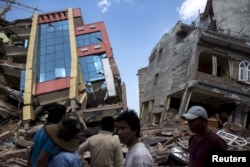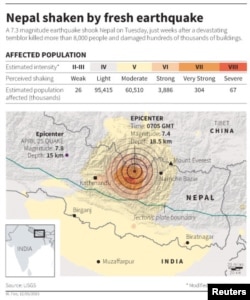A year after Nepal’s massive earthquake forced an Everest climbing expedition to withdraw from the mountain, climbers have returned to base camp.
“It’s quiet here; nobody bothers anyone,” Dr. Nima Namgyal Sherpa, an expedition organizer, told VOA's Tibetan service via low-signaled cellphone. “For me, it's normal business.”
Down below the tallest mountain on Earth, however, lives of people affected by last year’s 7.8 magnitude quake are far from normal. Nepal reconstruction efforts have been glacially slow: With the exception of several internationally protected world heritage sites, almost none of its estimated 800,000 damaged structures have been rebuilt.
On the far side of the Himalayas, Tibetan villages razed by that same quake also remain unchanged, their crumbled remnants seemingly abandoned, many of their estimated 100,000 internally displaced locals still without homes to return to.
Rongshar villagers
Like many Tibetan communities along the Nepal border, Rongshar Township was heavily damaged by the quakes. Unlike other quake-shattered towns, however, many Rongshar inhabitants refused to be relocated to Shikatse, Tibet's westernmost prefecture-level city, by the Chinese search-and-rescue teams that arrived days after the massive temblor struck.
Calling Rongshar more beautiful and lushly vegetative than Shikatse, the protesting Rongsharians echoed well-worn talking points of Beijing critics, who say China’s policy of moving Tibetan nomads and farmers into newly built towns is part of a deliberate strategy to suppress the traditional Tibetan way of life.
While many displaced Tibetans willingly relocated to Shikatse, Chinese authorities reportedly threatened Rongshar villagers who refused to budge, vowing to withhold aid if they insisted on staying.
One year later, some Rongshar villagers continue to live in tents.
“About two months ago, I managed to speak to [family in Rongshar]," Wang Bhumo, an India-based teacher, told VOA's Tibetan service. "They were still living in tents. I don’t know whether their houses are being built or not.”
Last Friday, Tibet Radio, China’s official Tibetan language news service, indicated that most relocated Tibetans still remained in Shikatse. The state newscaster also said Pema Trinlay, vice party secretary of the Tibetan Autonomous Region (TAR), recently visited Shikatse to reassure displaced Tibetans that quake reconstruction is a top priority for 2016.
The radio report, however, did not indicate whether reconstruction would focus on rebuilding damaged homes or erecting new towns.
China’s state-run Tibet Online News reported in November that 1,758 Tibetans who had been relocated to Shikatse were sent to “welfare homes” in a community described as Khulchung in the border town of Dram. A photo in the article showed an official passing boxes described as “gifts” to elderly Tibetans standing before rows of what appeared to be freshly built five-story structures.
Relocation efforts
In 2014, TAR officials said they had moved 2.3 million Tibetans into new homes, and that a five-year plan for Qinghai province aimed to relocate 90 percent of nomads by the end of 2014.
According to Radio Free Asia, China officials confiscated residency permits and other personal documents of Tibetan nomads in Yushu prefecture, Qinghai, because they refused to move from their pastureland home into “impoverished resettlement towns.”
While Chinese official news outlets have not reported whether Tibetans relocated to Shikatse have requested to return home or move into newly built developments, a February report by Tibet Radio suggested a dialogue was ongoing. According to that report, TAR Chairman Losang Gyaltsen visited Tibetans in Shikatse, where he “listened to opinions of the people” and told them that it was understandable that “people love their homes” and that there would be a brighter future for them.
Yeshi Dorje is a correspondent with VOA's Tibetan service.











